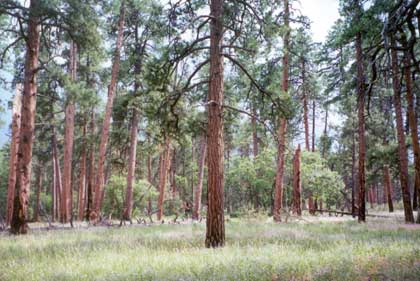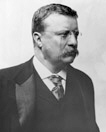
| Issue 3, Summer 2003 | ||||
In Depth: Without Old Growth, What of the Old West?
Flagstaff, Ariz.-- Perched on the North Rim of the Grand Canyon, the Kaibab Plateau is home to the highest remaining density and distribution of old growth trees and the species that depend upon them for survival. The Kaibab Plateau provides a vital biological link between the Grand Canyon-Parashant National Monument to the west, the Grand-Staircase and Paria/Vermillion Cliffs National Monuments to the north, and the Grand Canyon itself to the south. More than 170,000 acres of Forest Service land on the North Kaibab qualify for proposed wilderness. The Plateau covers approximately 850,000 acres of forested land directly north of the Grand Canyon. Roughly 500,000 of the 850,000 forested acres on the Kaibab Plateau are made up of increasingly rare old growth ponderosa pine and mixed conifer forests. Old growth is protected within the boundaries of Grand Canyon National Park. However, 80 percent of the old growth on the Kaibab Plateau lies within the Kaibab National Forest.
Intensive logging over the last one hundred and twenty years has destroyed more than 95 percent of the Southwest’s original old growth forests. Because of this, a1995 National Biological Survey declared the ponderosa pine forests of the Southwest one of the most endangered ecosystems in the nation. The Southwest Forest Alliance has launched an important campaign to protect and restore old growth forests in Arizona and New Mexico. Called Old Growth Forever! , the campaign seeks to increase the level of public awareness and outrage over the continued logging of rare old growth trees in the Southwest. The focus of this campaign is a proposal to create an old growth preserve on the Kaibab Plateau. As wild habitat becomes increasingly fragmented throughout the Southwest, corridors such as the Kaibab Plateau play an ever-greater role in the preservation of diverse and unique wildlife species. One of these species, the Kaibab Squirrel, is found nowhere else in the world and is a classic example of evolution through geographic isolation. In 1965, 200,000 acres of the ponderosa pine forest type included within the Kaibab National Forest was designated as a National Natural Landmark for Kaibab Squirrel Habitat.
The Kaibab Plateau also contains the greatest density of imperiled goshawks in the Southwest. Goshawk populations are in decline throughout the Southwest due to the loss of old growth habitat. Read an update about goshawk status here. The unique ecological values of the Plateau have been recognized since long before the goshawk population began to decline. Almost a hundred years ago in 1906, President Theodore Roosevelt created the Grand Canyon Game Preserve to protect the native fauna and flora of the region.
When Theodore Roosevelt first visited the Kaibab Plateau country on the North Rim of the Grand Canyon in the early 20 th century, he knew he had found paradise. At that time, the Plateau was a sublime oasis of towering, yellow-bellied ponderosa pine stands interspersed with lush native grasses, giving way at higher elevations to aspen, mixed-conifer and spruce-fir forest. Teeming with an incredible diversity of life both great and small, the Plateau was so inspiring to Roosevelt that he quickly endeavored to provide the area with permanent legislative protection. Roosevelt’s efforts successfully culminated with the 1906 passage of “An Act for the Protection of Wild animals in the grand Canyon Forest Reserve,” authorizing the President to designate areas within the Grand Canyon forest Reserve (today the Kaibab National Forest) which, in his opinion, should “be set aside for the protection of game animals and birds and be recognized as a breeding place therefore.” President Roosevelt quickly utilized his authority to create the “Grand Canyon Game Preserve,” encompassing nearly all of the present-day North Kaibab Ranger District as well as some Forest Service land on the South Rim. It is the only such Preserve within the eleven National Forests comprising the Forest Service’s Southwestern Region. Without
question, Congress and President Roosevelt intended the Grand Canyon
Game Preserve to serve first and foremost as a refuge for wildlife Unfortunately, today’s Forest Service has increasingly ignored its responsibility to make the protection of wildlife its highest management priority within the Game Preserve. Instead of viewing the Game Preserve designation and other factors—such as lack of a local timber economy and the proximity to Grand Canyon National Park—as an opportunity to protect and restore the Plateau’s wildlife and forests, the Forest Service continues to operate under industry-influenced, destructive management policies. These ongoing practices demonstrate a pressing need for explicit protections of the Kaibab’s old growth forests. If Theodore Roosevelt’s vision of the Game Preserve as a haven for wildlife is ever to be permanently realized, it will only be through the continued dedication and vigilance of concerned individuals and organizations. --by Roxanne George, Southwest Forest Alliance Old Growth Forever!To learn more about the Old Growth Forever campaign and how you can help protect the North Kaibab’s remaining old growth forests, visit the Southwest Forest Alliance website at: www.swfa.org , or contact us at swfa@swfa.org, (928) 774-6514.
|
||||

 Unfortunately,
in spite of the Forest Service’s many public pronouncements about management
focused on ecosystem health, old growth logging on the Kaibab is far
from a thing of the past. Logging of the Plateau’s expansive stands
of old-growth ponderosa pine intensified in the 1970’s, and escalated
to a frenzied pace during the 1980’s. Over 55,000 large old growth trees
have been logged during the last six timber sales on the north Kaibab.
Six thousand more will be logged in a current timber sale called Dry
Park.
Unfortunately,
in spite of the Forest Service’s many public pronouncements about management
focused on ecosystem health, old growth logging on the Kaibab is far
from a thing of the past. Logging of the Plateau’s expansive stands
of old-growth ponderosa pine intensified in the 1970’s, and escalated
to a frenzied pace during the 1980’s. Over 55,000 large old growth trees
have been logged during the last six timber sales on the north Kaibab.
Six thousand more will be logged in a current timber sale called Dry
Park. 


 Our
list of outdoor events has diminshed somewhat due to the Arizona summer heat,
but take a look anyway! We are offering several exciting wilderness excursions
around the state.
Our
list of outdoor events has diminshed somewhat due to the Arizona summer heat,
but take a look anyway! We are offering several exciting wilderness excursions
around the state. 
